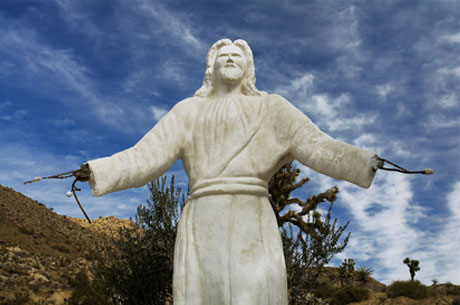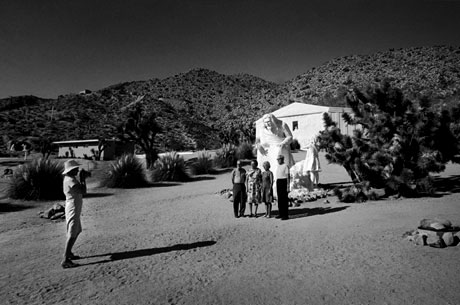|
 Sermon
on the Mount, Desert Christ Park, Yucca Valley CA
Sermon
on the Mount, Desert Christ Park, Yucca Valley CA
Overlooking the high desert town of Yucca Valley in Southern California, Desert Christ Park features larger-than-lifesize, snow-white sculptures portraying scenes of Christ's life and teachings. They were created by artist-sculptor Antone Martin a half-century ago as a world peace shrine. Martin died in 1961 at the age of 74 after completing more than 50 statues. The individual figures weigh anywhere from three to sixteen tons each. Martin started sculpting the steel-reinforced, concrete figures during the height of the A-bomb scare in the mid-1940s, hoping to construct pieces that that could withstand a nuclear bomb.
In
1968, photographer Ryan Herz was on his way to the Giant Rock UFO Convention
when he came across a small sign pointing him off the highway to
Desert Christ Park. He was struck by the passion of whoever had
made the creation of the place his life’s work. Ryan’s Catholic
training, while giving him a great love and respect for the images of
religion, was far behind him. But the juxtaposition of a benevolent Jesus
in the secular present was very appealing.

In 2004 Ryan returned, this time armed with the digital technology that
could give him on paper the colors he saw. The passage of time, with its
earthquakes and ideological shifts, had not been kind. But the place and
the statues still had a certain grace that had withstood those tumultuous
times. “Although I had originally photographed the park in b&w,
I always felt that Desert Christ Park called for color.
The b&w images have an archival power that time has given them, but
the very traditional Christian color scheme of rich blue vs.white works
better.”
watch the video on
youtube
The last time he was in the park was in the snows of winter, “I
was photographing the Christ of the Sermon on the Mount. His hands, once
beautiful, then missing, had been rather clumsily replaced. I realized
that I had really never touched one of the statues. I reached up and put
my hand on his solar plexus. I have always described myself as an atheist
who loves gospel music. He was not God to me, but we’d been through
a lot together.”
Ryan Herz attended Art Center in Pasadena and the San Francisco
Art Institute. He has been exhibited locally and in San Francisco,
New Orleans and New York. Herz has completed the photo essays Route
5, Women on Display and The
Children of Edgewood.
On display concurrently in the Project Room::
At
the End of the Pavement: Churches of the American South
Photographs by R.H. Sturges
 “Greater
Miracle Temple Church of Christ Apostolic” Charleston County, South
Carolina. 2001
“Greater
Miracle Temple Church of Christ Apostolic” Charleston County, South
Carolina. 2001
Throughout his many peregrinations, R.H.Sturges became aware of how quickly
the world of his youth had changed. “Many of the wooden churches
had been bricked over and lost their charm and character with their modernization.
Other churches were swallowed up by the Kudzu vines, or simply left to
rot. Some have disappeared completely. Although there is a sense of sadness
to the loss, there was another feeling that overpowered it. It was the
feeling of peace and tranquility and I try to convey that in my photographs.”
“The title and inspiration for At the End of the Pavement comes from my great Aunt Hazel who was the local florist and my best friend." Sturges explains, "She would take me along on her deliveries to “fix flowers” for funerals and weddings. “Lets go for a ride to the end of the pavement," she would say on those hot summer evenings. Although the term originated in a time when the paved roads ceased at the town limits, the essence of it was still present. As I grew up. I realized how unique the churches in the South were and decided to combine my passion for photography with my love of the little churches of Franklin County and the South.”
R.H.
Sturges’ documentary style of photography calls to mind Minor White
and Walker Evans’ images of the South in the 1930’s. A timeless
yet fragile slice of an almost forgotten past.
R.H. Sturges was born and raised in the small town of Louisburg, North
Carolina. His love for photography began in the sixth grade when his grandfather
gave him a camera. He graduated from Episcopal High School in Virginia
and spent his senior year studying language and art in Barcelona, Spain.
After a year off, he matriculated and attended classes at the University
of Georgia.
